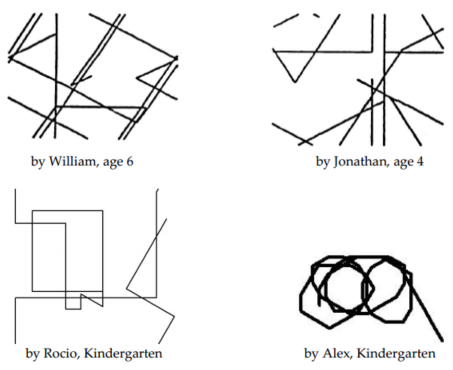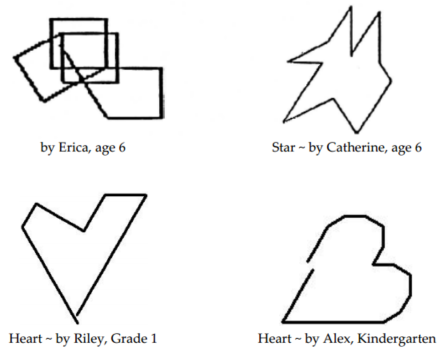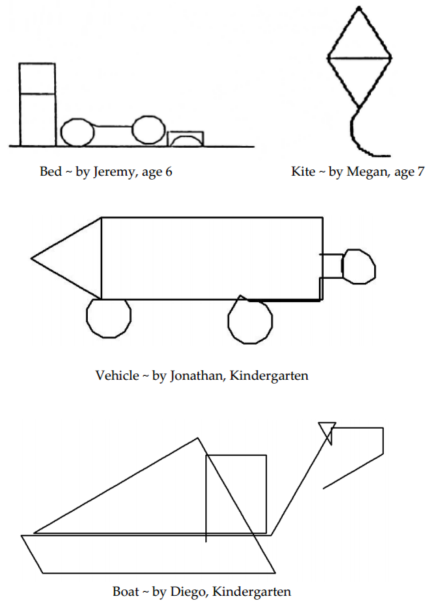The Exploration Stage
This section will help you guide your children as they use Kinderlogo Level 1. You will find out what to expect from your children’s explorations, and how to help them get the most out of Kinderlogo.
Allow sufficient time for them to “explore” with the turtle, to experiment with it, and investigate its domain. Most children will go through a series of definite stages.
These are the same stages through which children progress using any art medium. If you give a child crayons, paint, or clay for the first time, you will see “scribbles” before you see recognizable objects. The child may gain a feeling for the medium and explore its limits
With Kinderlogo, first will come random turtle movements that soon wrap around all sides of the screen. The children are exploring the boundaries of the turtle’s space. It is very important the children are allowed unlimited exploration time. Their initial drawings may look aimless and random to us, but the children are developing an awareness of how the turtle moves and how their commands create the result on the screen. These beginning explorations may last for weeks or even months. Do not push the child into “making something.”
One very bright six-year-old, Seth, made what appeared to be random line drawings for an extended period of time. His understanding parents patiently asked after each weekly session, “Did he make anything today?” For weeks the answer was, “Not yet.” However, their tolerance of this behavior was justified when pictures did begin to form and he quickly advanced through all the other Kinderlogo levels, showing a superior grasp of the more complicated Level 5 commands used to define procedures. Clearly, he needed that amount of time to become familiar with the turtle’s environment before taking off at a quick pace through all that Kinderlogo could offer him. You will see some of Seth’s pictures later in this guide.
A slow start is not necessarily a bad sign. In fact, in this case, pushing this child into making a picture before he was ready could have destroyed his interest and capabilities.
The following are some typical beginning Kinderlogo pictures. They may not mean much to you, but the children were making important discoveries that would influence their later development. Shapes sometimes occur in beginning explorations, but they are generally accidental.
Early stage of exploration

Drawings become more purposeful at the next stage
In the next stage of development, the pictures become smaller, with more purposeful movements. Specific shapes such as squares, rectangles, and triangles usually appear. These shapes may be alone on the screen or they may be an isolated display of structure in an otherwise random drawing. At this stage, children begin to have definite goals and may make up names for their creations. The following pictures illustrate this second level of exploration.

Shapes combine at the next stage
Various shapes then start to combine with one another in the development of a representational or symbolic stage. Eventually, definite images or pictures, such as houses, trees, balloons, or alphabet letters appear. Finally, these images unite to form a composite picture.

These are the pictures that you were probably expecting from the start. Give the children plenty of time and they will create similar imaginative designs. Allow the children time to experiment and learn through discovery. If you choose to sit with your child, try to be a “silent” partner. Children want to please and will try to “make something” just to satisfy you. When left on their own, they will not be afraid to try out things at the risk of “spoiling” their creation.
